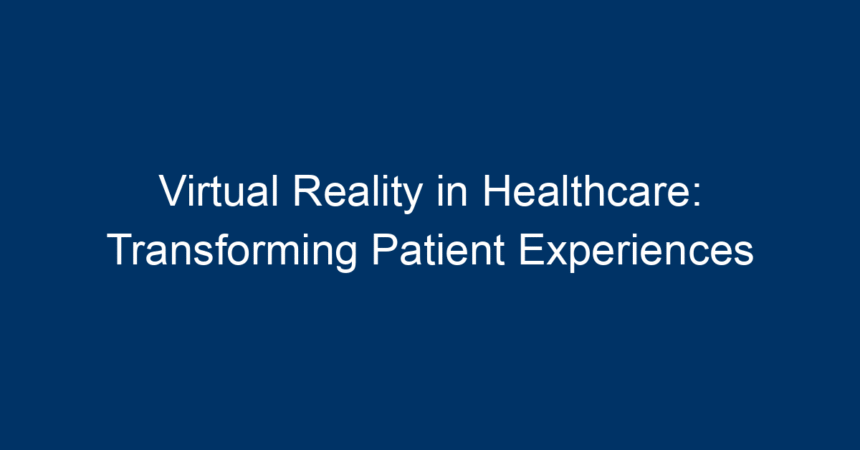In an age where technology is evolving at lightning speed, healthcare is not left behind. Among the most exciting developments is the rise of virtual reality in healthcare. This innovative technology is revolutionizing the way medical professionals interact with patients, educate, and deliver care. By immersing patients in virtual environments, healthcare providers can enhance therapeutic experiences, streamline training procedures, and even assist in pain management. In this article, we will delve into how virtual reality is transforming patient experiences and reshaping the landscape of healthcare.
Understanding Virtual Reality in Healthcare
Virtual reality (VR) is a simulated experience generated by computer-generated content that can either mirror or differ from the real world. It immerses users in a 3D environment, often through the use of headsets and controllers, allowing for interactions that feel incredibly realistic. The application of VR in healthcare has proven to be beneficial in numerous areas, including patient treatment, medical education, and surgical training.
Key Benefits of Virtual Reality in Healthcare
1. Enhanced Pain Management
One of the most compelling uses of virtual reality in healthcare is its effectiveness in pain management. Clinical studies have shown that immersing patients in a VR experience can distract them from pain and anxiety during medical procedures. For instance, burn patients or those undergoing wound care can benefit from VR by engaging in calming environments, which have been found to reduce the perception of pain significantly. This innovative approach may reduce the need for opioid medications, addressing one of the most critical issues in today’s healthcare crisis.
2. Improved Patient Education
Educating patients about their conditions and treatment plans has always been a vital aspect of healthcare. Virtual reality facilitates this process by providing immersive educational experiences. Patients can visualize their anatomy and understand complex procedures more effectively. For instance, VR modules can allow patients to "walk through" a surgery step-by-step, helping them grasp what to expect. This understanding not only enhances the patient experience but also fosters compliance and satisfaction with treatment plans.
3. Support for Mental Health Treatment
Mental health issues, including anxiety, PTSD, and phobias, can be particularly challenging to treat. Virtual reality in healthcare has emerged as a powerful tool in therapeutic settings. Exposure therapy using VR allows patients to confront their fears in a controlled environment, gradually helping them learn coping mechanisms. For instance, individuals with a fear of flying can simulate being on an airplane, thereby reducing anxiety levels over time.
How VR is Reshaping Medical Training
1. Realistic Training Simulations
Medical professionals must undertake extensive training before they can treat patients confidently. Virtual reality provides a safe and controlled environment for this training. Medical students can practice complex procedures, such as surgeries, on virtual patients without putting real lives at risk. This approach not only enhances skills but also builds confidence, leading to better patient outcomes once these practitioners enter the field.
2. Collaborative Learning Environments
Another exciting aspect of VR in medical training is the potential for collaboration among students, regardless of their physical location. Virtual environments can enable healthcare professionals in different regions to learn and practice together. This shared experience can facilitate tele-education, where experts conduct training sessions that students can join virtually, ensuring they have access to the best education regardless of location.
Virtual Reality for Rehabilitation
In the realm of rehabilitation, virtual reality in healthcare is making waves. This technology allows for engaging exercises that motivate patients to participate actively in their recovery. For example, stroke patients can practice movements through immersive games that encourage the use of affected limbs, turning rehabilitation into an enjoyable experience.
1. Customizable Treatment Plans
VR platforms can be tailored to create specific rehabilitation plans based on individual patient needs. The interactive nature of these programs ensures that therapists can adjust difficulty levels and settings, making rehabilitation both personalized and dynamic. This customization leads to higher engagement and adherence to therapy, ultimately improving recovery times and outcomes.
Future of Virtual Reality in Healthcare
The future of virtual reality in healthcare looks promising. As technology advances, we can expect even more sophisticated applications in various areas of medicine. From enhancing diagnostic imaging techniques to creating realistic simulations for surgeries, the possibilities are expansive.
1. Integration with Other Technologies
As VR technology matures, its integration with other technologies—such as artificial intelligence (AI) and augmented reality (AR)—is likely to grow. This convergence could lead to more comprehensive treatment plans and enhanced learning experiences for medical practitioners.
2. Increased Access to Healthcare
Virtual reality also holds the potential to extend healthcare services to underserved populations. Remote consultations and therapies can be conducted through VR platforms, making healthcare more accessible to those in rural or isolated areas, thereby improving overall public health.
Implementing Virtual Reality in Healthcare
1. Overcoming Barriers
Despite its benefits, the implementation of virtual reality in healthcare does come with challenges. High costs, technological hurdles, and a lack of awareness among healthcare professionals can impede adoption. To move forward, healthcare systems must invest in training and resources to educate practitioners about the benefits and practical applications of VR technology.
2. Collaboration between Industries
Collaboration between healthcare professionals, technology developers, and educational institutions is crucial for the successful integration of VR into healthcare systems. By working together, these entities can develop tailored VR solutions that meet the unique needs of the medical community.
Conclusion: The Transformative Power of Virtual Reality in Healthcare
The integration of virtual reality in healthcare represents a significant leap forward in patient care, education, and rehabilitation. By enhancing pain management, improving patient education, aiding mental health treatment, and reshaping medical training, VR is transforming the way we approach healthcare. As the technology continues to evolve, it is imperative for healthcare providers to explore and implement VR solutions that will ultimately lead to improved patient outcomes and experiences.
Actionable Insights
-
Stay Informed: Healthcare professionals should stay updated on the latest advancements in virtual reality and its applications in the healthcare sector.
-
Get Trained: Seek training opportunities in VR technology to understand its functionalities and how to integrate it into patient care effectively.
- Monitor Patient Feedback: Collect feedback from patients using VR-based interventions to assess effectiveness and make necessary adjustments to treatment plans.
The journey of virtual reality in healthcare is just beginning, and its potential to reshape patient experiences is immense. Embracing this technology could lead to a future where healthcare is more effective, compassionate, and accessible for all.




